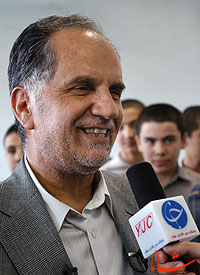Gas would be injected into Phase 6 of SP within next 15 days, said the minister, adding Phase 7 would start its production two months after the Phase 6 exploitation and Phase 8 would be put into operation in winter.
“The project is progressing rapidly as 76 percent of the operations has been done,” said Vaziri-Hamaneh, expressing hope the pipe-laying of phases 6-8 would be complete when the refinery in Aghajari was constructed.
He pointed to negotiations with the managers of phases 9-10 development plans, predicting Phase 9 would join the national gas grid by late December 2007.
The minister paid a visit to SP phases 6-8 and Mehr and Kavian petrochemical complexes and was briefed on the projects.
Managing director of Pars Special Economic Energy Zone said when all 28 phases of South Pars field came on stream, the field would fetch the country 40 billion dollars per annum.
Seyed Abdoljalil Razavi added that there were 4 million jobless people in the country and South Pars held good promises for job creation.
The official noted that the government of
He stated that
“
Razavi noted, “Due to vastness of
Managing director of Pars Special Economic Energy Zone further stated that five gas refineries were currently operating in the region, which fetched 20 million dollars in benefit every day.
The official added that 190 billion rials (20.5 million dollars) had been allocated to various infrastructure projects in
Recalling his promise on inauguration of a petrochemical complex every month, the minister said Ghadir and Borzouyeh petrochemical complexes were ready, waiting for the presence of the president or a ranking official in their opening ceremonies.
Shifting to talks on development of North Pars gas field, he said, “We have held negotiations with the Chinese party and the studies show that the Chinese company has good capacity to do the job.”
The two sides were satisfied with their negotiations and were now discussing the signing of the contract, he added.
Akbar Torkan added that POGC and China National Offshore Oil Corp. (CNOOC) would ink the contract by
“According to the negotiations, the phases are to produce 20 million tons of LNG per year,” he said.
The topics of last round of IPL talks revolve around unsettled issues.
During his last month visit to
Discussions between
“The talks now hinge on agreement over the tariff to be charged by
The minister said he did not expect there to be any major delays in signing a full sales and purchase agreement.
“The commercial agreement is nearly complete -- we are working very sincerely,” he said.
Deora said Pakistani Prime Minister Shaukat Aziz had assured the Indian government during his early April visit to New Delhi that Pakistan’s tariff charges for Iranian gas to be supplied to India would be in line with international norms.
Asked how much
“We are working it out now. It’s a long-term agreement and it should be at a correct price. A price of $6 per one million BTU is definitely too high,” he said.
The tripartite pipeline is a proposed 2,775 km gas pipeline project to deliver natural gas from
The project is expected greatly benefit both
The project was conceptualized in 1989 by Ali Shams Ardakani and R. K. Pachauri. Ardakani is a former top diplomat and deputy minister of mines and metals of
At the annual conference of the International Association of Energy Economics, 1990, Ardakani backed Pachauri"s proposal.
The pipeline is proposed to start from Assalouyeh, a port city in southern Iranian


Your Comment